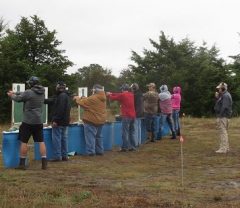Recently, I was working with a student to fine-tune his shooting. We adjusted his grip, talked about the right part of the finger to put on the trigger, talked about treating the trigger as a “dimmer” and not a “light switch”, and slowed down the trigger squeeze, but he kept shooting quite low. The groups were very good, but consistently low. I thought at first he was just anticipating recoil, and pushing on the gun, until I saw a vibration of the muzzle right before the trigger break. I dry-fired his gun to prove it would not be there, then had him do it. I saw the same vibration. More importantly, he also saw it.
Both the problem and the solution were simple. His gun had a fair amount of take-up (slack, or pre-travel) in the trigger. While I instinctively took up that slack before squeezing, he did not. He was squeezing from the very beginning of trigger movement, and when he hit the sear, it was like hitting a curb on a bicycle. That bump was causing the vibration, which manifested as pitching forward.
It should be noted that some triggers have little or no take-up, and some ramp up smoothly from the beginning of movement to the break, without that bump. It depends on the design of the gun, and to a certain degree, its cost.
Once he understood the need to pull up to that “curb” before squeezing, his groups moved up where they should be. Once again, dry-firing pointed the way to the solution. Navy SEALs do an extended dry-fire routine before every training session. Do you?
